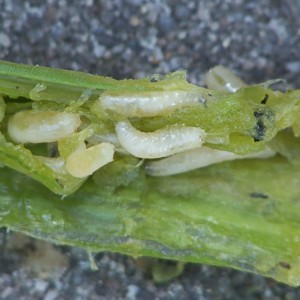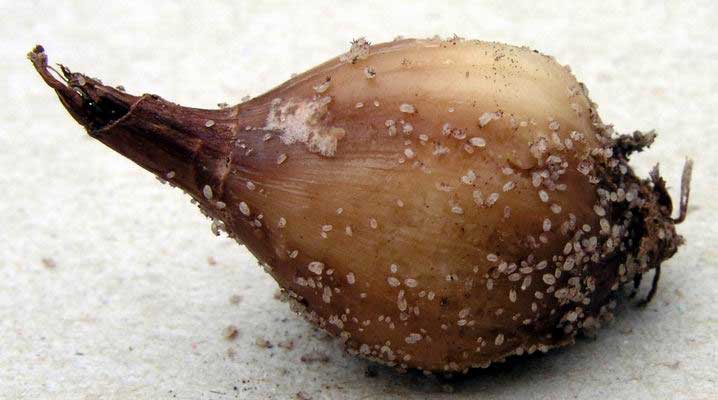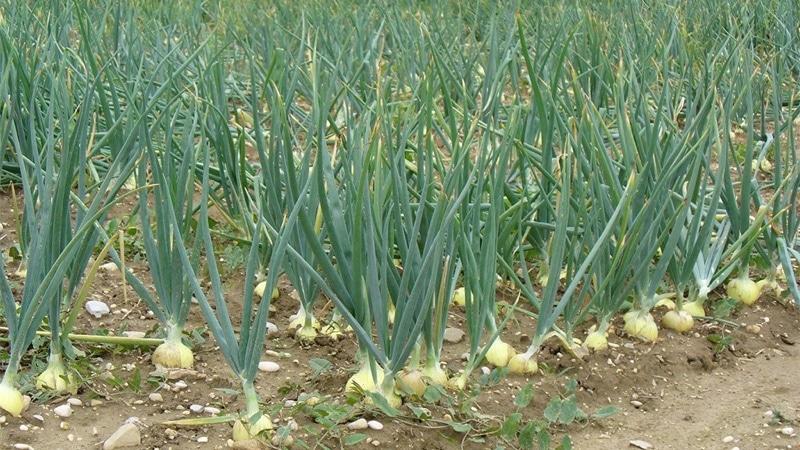What are the pests of onions and methods with them
Onions are present in the diet of almost every Russian. Even the smallest summer cottage must have a place for an onion garden.
However, this is the simplest crop in agricultural technology. When growing onions, gardeners often face diseases and pests. Insects damage crops or destroy them completely. In the article we will talk about pests onions and how to deal with them.
The content of the article
Pest symptoms
Pests affect onions both during the growing season and during storage.
Symptoms:
- discoloration of green feathers;

- the appearance of spots and stripes on the leaves;
- drying of feathers;
- the softness of the bulbs;
- the appearance of plaque on the plant.
There are other reasons for the yellowing and drying of feathers. For example, acidified soil, lack of nitrogen, copper or potassium, excess moisture in the soil. If you are sure that everything is in order with the soil and the onion is not sick, then the matter is in the invasion of pests.
Need to know... Onion pests are dangerous not only for onion beds, but also for related plants: garlic, tulips, daffodils, lilies.
What pests affect onions
How many enemies do the turnip have? Yes many. Let's list the most dangerous of them.
Onion fly
Onion fly also called the onion flower girl. She hits the onion, leek, shallots, to a lesser extent - garlic and chives. Also dangerous for bulbous flower crops, especially tulips.
Adults are ash-gray, 6-8 mm long. Legs are black, wings are slightly yellowish. Eggs are white, elongated, about 1.2 mm. The larvae are worm-like, dirty-white, up to 10 mm long. They also eat plants, leading to their death.
Flies emerge from pupae in spring when cherry blossoms begin. Females lay their eggs on the soil in onion beds or directly on dry scales. After 6-7 days, larvae hatch from the eggs and begin to eat the crops.
The larvae cause the greatest harm to the plantings during the period of their growth and the beginning of development. Planting of onions sown with seeds to obtain seedlings suffer greatly from the pest, since the sprouts are located close to each other and the larvae crawl from dead plants to neighboring healthy ones.
Attention. Onions affected by neck rot and stem nematode are especially severely damaged by onion fly larvae.
The parasite is recognized by the larvae inside the heads. On the bases of the cotyledons and leaves, the larvae themselves are visible. Damage leads to yellowing and wilting of the leaves, subsequently the bulb rots, and the plant itself dies.
Onion stem nematode
This worm is only 1-1.5 mm long. Damages all bulbous crops. Adults live in the soil and from there penetrate the heads. Nematode lays eggs in the bulb and the young individuals that come out of them begin to eat the tissues inside the bulb.
Need to know. The pest lives in the soil for several years in a state of suspended animation, so it is extremely difficult to fight the nematode.
Lightened, twisted feathers are signs of damage, swelling appears on the lower part of the leaves. It is almost impossible to see the nematodes themselves due to their small size.
Reproduction of the parasite leads to rotting of the onion heads and drying out of the aerial part of the plants. The worm hibernates in the soil, on plant residues of onion crops. The nematodes that have settled inside the bulbs hibernate in storage.
Weevil
The weevil, or onion lurking beetle, is a dark gray or black beetle with a proboscis... The length of the pest is only 2.5-2.7 mm. Crops damage both the beetles themselves and their larvae. They are light-colored caterpillars with brown heads 6-6.5 mm long.
They feed on the pulp of onion feathers. Weevil is not dangerous for bulbs, but damage to the green part of plants leads to a decrease in yield.
The lurker wakes up in mid-April. First, it feeds on unharvested remains, then moves on to young shoots. Females lay eggs inside the tubular leaves of the onion. The hatched larvae actively eat the flesh of the feathers.
Hoverfly
Along with the onion fly, the hoverfly damages onions, garlic and ornamental bulbous crops... An adult reaches a length of 10 mm. The hoverfly larvae are worm-like, greenish-gray in color, their entire body is covered with short spines.
The pest overwinters in plant debris in the soil and stored bulbs. The larvae pupate in the spring, and at the beginning of summer, a massive summer of adult hoverflies begins. Females lay eggs between dry scales of bulbs and larvae appear after 7-8 days.
Affected bulbs rot and quickly decompose from fungal and bacterial diseases.
Onion thrips
Another small pest with a length of only 1 mm. Planting is striking both in closed and open ground. The parasite is dangerous because it sucks the juices from the onion greens, preventing the bulbs from growing fully.
An insect invasion can be recognized by whitish spots on feathers, twisted, yellowed leaves. With severe damage, the plant dies.
Females lay eggs under the skin of the leaf. After a week, larvae emerge from the eggs and begin to feed on plant juices.
Important. During the summer, it develops up to 3-6 generations of thrips, and in greenhouses - up to 6-8. The parasite harms not only onions, but also garlic, cucumbers, cabbage, radishes, eggplants.
It hibernates in the soil and in plant debris at a depth of 5-7 cm, in greenhouses, hotbeds and in onion storage under dry scales, where it reproduces throughout the winter.
Onion moth
The onion moth is a small butterfly with a wingspan of about 1.5 cm. The color is brown with white specks.
Onion moth larvae harm plantings of onions, garlic, as well as ornamental bulbous crops. They gnaw through the tissue of the leaves and eat them from the inside, while the skin remains intact.
Damaged foliage wilts and then dries up. During the summer, the onion moth gives 3-4 generations. The first begins to harm plantings in May-June.
Larvae hibernate mainly under plant debris.
Root mite

The mite damages the bulbs of onions, garlic, tulips, daffodils and other bulbous crops.
It primarily affects damaged or diseased plants. Loves warmth and moisture (temperature + 26 ... + 28 ° С and humidity over 50%). Under favorable conditions, it develops quickly, a new generation appears within 10 days. One female lays 350 to 800 eggs.
The pest enters the bulb through the bottom. Damages the rudiments of peduncles and leaves, thereby reducing the quality of the planting material. Planting an infected set contributes to the further spread of the tick.
The root mite spreads with the remnants of damaged plants, soil and garden tools.
Shallot aphid
Small pest of brown or red-brown color. The main food plant is shallots, but it also damages other species. Aphids carry viral diseases.
It gets to the beds with planting material. In greenhouses, the greatest damage is caused to forcing onions in the autumn-winter and early spring periods.
Shallot aphids overwinter in greenhouses, on weeds and in bulbs between scales, in vegetable stores. After planting the onions in the greenhouses, the aphids move to juicy scales and leaf bases.
It settles on scaly leaves under the outer shell of the bulb and on young leaves. Affected plants are stunted, leaves bend and wither.The feather is contaminated with honeydew and molted skins.
Leaf beetle
The leaf beetle is a beetle 6-7 mm long. Elytra are orange-red, abdomen black, legs red. The larva is gray, its head and legs are black. Dangerous for onions, garlic, lilies, lily of the valley and other lily crops.
The leaf beetle leaves its wintering grounds at the end of April. First, they feed on wild plants from the lily family, then move on to onion and garlic beds.
The female lays eggs on the leaves, from which the larvae emerge. It is they who harm the crops by eating holes in the leaves. Severe damage to the feathers slows down the growth of the bulbs and leads to the death of the plant.
Onion sharpener
Another pest of onions and garlic, common in the Rostov region and Krasnodar region.
The onion sharpener is a moth with a wingspan of about 2.5 cm. The body of the moth is covered with thick hairs. The color of the wings is light brown, the front wings have a brown pattern, the rear ones have a variegated fringe. The caterpillar is flat, reddish above, yellowish below, up to 2.5 cm long.
Caterpillars hibernate in the soil. Pupate in the spring. The emerged butterflies lay eggs, from which larvae emerge. Caterpillars bite into the bulbs and eat out large cavities in them. Together with the caterpillar heads, the caterpillars enter the storehouses, where they continue to feed and pupate.
Control methods
Among the methods of pest control of onions are folk remedies, chemical, mechanical, agricultural techniques. Let's consider each of these methods in more detail.

Folk remedies
Folk remedies are good because they are harmless to humans. It is with them that the fight against onion pests begins.
- Soak the seedlings before planting in a strong salt solution for two hours. Then the onion is thoroughly washed in clean water, changing it several times.
- Adding insect repellent to the aisles. Tobacco dust, fluff lime will do; naphthalene mixed with sand. The soil around the garden is sprinkled with these agents once a week.
- Treatment of the soil around the bulbs with a mixture of wood ash, tobacco dust and ground pepper (in a ratio of 4: 1: 1). About 200 g of such a mixture is used for one square meter of 1 m².
- Spraying plants with an infusion of 200 g of tobacco dust, soap and ground pepper. To prepare the solution, take 10 liters of hot water, mix with tobacco and leave for 2-3 days. Before spraying, add 1 tbsp to the mixture. l. liquid soap and 1 tsp. ground pepper. Both plants and soil are treated with a filtered solution.
- Marigolds, planted next to onions, scare off onion flies and restrain the reproduction of nematodes.
- At the first detection of a lesion with thrips, spraying with yarrow infusion is effective.
If folk remedies are ineffective or there are too many pests, they switch to using chemicals.
Chemicals
When using chemicals, consider:
- When growing onions on a green feather, they are not used.
- When processing, follow the instructions of the manufacturer of the product.
- Pests develop immunity to drugs, so change them from time to time.
Of the chemicals used to combat onion pests, "Medvetoks", "Zemlin", "Mukhoed" are used. These funds are applied to the soil surface and then loosened. Spraying of plants with preparations "Sochva", "Iskra DE", "Fitoverm" is also used.
Mechanical methods
Mechanical methods of onion pest control:
- protection of young crops with covering material - an obstacle for onion flies and hoverflies to lay eggs on plants;
- mulching plantings with peat chips - all flies avoid peaty soils;
- shelter of onion plantings for the winter with spruce branches - in the spring, crumbling needles will scare off an onion fly;
- timely removal and burning of affected plants, weeding;
- drying and bulkhead onions before storing.
Agrotechnical methods
Among agrotechnical control measures, the following are distinguished:
- cleaning of all plant residues from the site after harvesting;
- autumn digging of the soil, destroying the wintering sites of pests;
- compliance with the rules of crop rotation - the place for growing onions is changed after 1-2 years;
- early planting of bulbous crops - young plants have time to get stronger by the time the pests appear;
- loosening row spacings with subsequent watering and top dressing;
- removal and burning of damaged plants;
- careful selection of seed.
Prevention measures
Prevention consists in observing the following rules:
- before laying vegetables, the storage is thoroughly cleaned of plant residues;
- disinfection of the premises by burning sulfuric bombs "Climate" or "FAS" at the rate of 30 g per 1 m³ or gassing with sulfur dioxide for 24-36 days;
- the cleaned and disinfected storage facility is ventilated and whitewashed with lime - it is harmful to many pests;
- the harvest is harvested in dry weather, before laying the onions for storage, the onions are dried at a temperature of + 35 ... + 37 ° С for a week;
- before planting the sets, carefully inspect and remove damaged specimens.
Conclusion
Onion pest control is an urgent issue for everyone who is engaged in the cultivation of this crop. In order to prevent harmful insects, it is important to observe crop rotation, water it correctly, process the site before sowing, and avoid planting thickening. The quality of the seed is important, since pests often hibernate inside the bulbs.